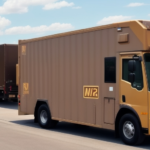Understanding UPS Shipping Rates and How to Calculate Phone Orders
Shipping rates are a critical consideration for businesses that rely on delivering products to customers. Understanding the various factors that influence shipping rates is essential for accurately calculating and managing these costs. This is particularly important for companies that receive orders via phone, as determining shipping costs in these scenarios can be challenging. In this article, we will delve into the different types of UPS shipping services, provide tips to reduce shipping expenses, and explore strategies to effectively manage phone orders and shipping processes.
Why Understanding UPS Shipping Rates is Important for Your Business
Grasping the nuances of UPS shipping rates is vital for any business that ships products to customers. Accurate calculation of shipping costs helps businesses maintain profitability and prevent unexpected expenditures. Additionally, being knowledgeable about the various UPS shipping services and their associated costs can enhance delivery times and boost customer satisfaction.
Furthermore, a comprehensive understanding of UPS shipping rates empowers businesses to make informed decisions regarding their shipping strategies. For example, businesses might offer free shipping by incorporating shipping costs into product prices or provide discounted shipping for bulk purchases or orders exceeding a certain amount. Leveraging UPS shipping rates effectively can create a competitive edge and attract a larger customer base.
According to the UPS 2023 Annual Report, efficient shipping rate management can lead to a significant increase in customer retention and overall business growth.
Different Types of UPS Shipping Services Available
UPS provides a range of shipping services tailored to meet the diverse needs of businesses. These services vary from standard ground shipping to expedited and international shipping options. Each service type has distinct costs and delivery times, making it crucial for businesses to assess their specific needs and choose the most suitable option for each shipment.
One of the most sought-after UPS shipping services is the Next Day Air option, which guarantees delivery by the next business day, making it ideal for urgent shipments. Another popular choice is the UPS 2nd Day Air service, ensuring delivery within two business days. While these services come at a higher cost compared to standard ground shipping, they offer significantly faster delivery times.
For businesses that frequently ship internationally, UPS offers several international shipping services such as UPS Worldwide Express, which guarantees delivery within one to three business days, and UPS Worldwide Expedited, ensuring delivery within two to five business days. These services include features like customs clearance and package tracking to facilitate a seamless delivery process.
- UPS Ground: Cost-effective option for domestic shipping with delivery typically in 1-5 business days.
- UPS 3-Day Select: Guarantees delivery within three business days.
- UPS Standard: Economical choice for non-urgent shipments to Canada and Mexico.
- UPS Express Critical: For time-sensitive and high-value shipments requiring immediate attention.
How to Calculate Shipping Costs for Phone Orders
Determining shipping costs for phone orders can be more complex than for online orders due to the absence of automated shipping calculators. Key factors to consider include package weight, destination, and the selected shipping service. Many businesses utilize UPS shipping rate charts to swiftly and accurately calculate shipping costs for phone orders.
Additionally, the size of the package plays a crucial role in shipping cost calculation. Larger packages may incur extra fees or require special handling, impacting the overall shipping cost. It's also essential to communicate any potential shipping delays or issues with customers to maintain a positive customer experience.
According to Statista, approximately 30% of online shoppers cite shipping costs and delays as primary reasons for cart abandonment, highlighting the importance of accurate shipping cost calculation.
Tips to Save Money on UPS Shipping Rates
Businesses can implement several strategies to reduce UPS shipping costs. Negotiating rates with UPS based on shipping volume is an effective approach. Additionally, taking advantage of UPS's packaging options can lead to cost savings. Properly weighing and measuring packages to avoid dimensional weight charges is also crucial in minimizing shipping expenses.
Utilizing UPS's online tools and resources, such as shipping calculators and rate quotes, allows businesses to compare rates and select the most cost-effective shipping options. Furthermore, using UPS's tracking and monitoring tools ensures shipments are managed efficiently, reducing the likelihood of delays and errors.
Exploring alternative shipping carriers like USPS or FedEx for certain shipments can also result in lower rates. Researching and comparing rates from multiple carriers ensures businesses find the best shipping solutions tailored to their specific needs and budgets.
- Bulk Shipping: Consolidate multiple shipments to benefit from volume discounts.
- Prepaid Labels: Purchase shipping labels in advance to secure lower rates.
- Packaging Optimization: Use appropriately sized packaging to avoid excess dimensional weight fees.
- Frequent Shipper Programs: Enroll in UPS's loyalty programs to access exclusive discounts.
Factors That Affect UPS Shipping Rates and How to Manage Them
Several elements influence UPS shipping rates, including package size, weight, destination, and the chosen shipping service. Assessing these factors is essential to select the most appropriate shipping option for each shipment. Efficiently managing and streamlining the shipping process can help mitigate unnecessary costs and prevent delays.
The type of item being shipped also affects UPS shipping rates. Certain items may require special handling or packaging, increasing shipping costs. Properly labeling and packaging items ensures safe and efficient shipping. Additionally, leveraging UPS's online tools and resources aids in managing shipping costs and tracking shipments in real-time.
According to UPS's shipping guidelines, optimizing package dimensions and weight can significantly reduce shipping costs by minimizing dimensional weight charges.
How to Negotiate Better UPS Shipping Rates with Your Carrier
Negotiating improved UPS shipping rates can substantially enhance a business's profitability. One effective strategy is leveraging shipping volume to secure discounted rates with UPS. Exploring different shipping services and options to identify the most cost-efficient solutions for each shipment is also beneficial.
Analyzing shipping data to identify optimization opportunities can lead to reduced shipping costs. For instance, consolidating multiple shipments or adjusting packaging to decrease weight and size can result in significant savings.
Maintaining a strong relationship with your UPS representative is crucial. Regular communication and providing feedback on shipping experiences can foster a partnership that yields better rates and enhanced services. Staying informed about industry trends and regulatory changes ensures preparedness for potential rate adjustments or shipping regulation modifications.
- Volume Commitment: Agreeing to ship a minimum volume can secure better rates.
- Flexible Billing: Exploring different billing structures that align with your shipping patterns.
- Service Bundling: Combining multiple UPS services to achieve cost savings.
- Regular Reviews: Periodically reviewing your shipping needs and renegotiating rates as necessary.
Best Practices for Managing Phone Orders and Shipping
Efficient management of phone orders and shipping processes can lead to significant time and cost savings. Implementing a reliable order management system streamlines the order and shipping workflow. Accurately weighing and measuring packages, selecting the appropriate shipping service, and correctly labeling packages are crucial steps to ensure timely and efficient delivery.
Providing customers with accurate and up-to-date tracking information minimizes inquiries and complaints, enhancing customer satisfaction. Negotiating favorable shipping rates with carriers further reduces costs and improves profit margins.
Establishing a clear and concise returns policy for phone orders is also essential. A straightforward returns process reduces customer confusion and frustration, minimizes return-related costs, and fosters customer loyalty and repeat business.
- Automated Order Entry: Use software to quickly enter phone orders into your system.
- Employee Training: Ensure staff are well-trained in calculating shipping costs and handling orders efficiently.
- Customer Communication: Keep customers informed throughout the shipping process with regular updates.
- Inventory Management: Maintain accurate inventory records to prevent shipping errors and delays.
Common Mistakes to Avoid When Calculating Shipping Costs for Phone Orders
Avoiding common pitfalls in shipping cost calculation is essential to prevent unexpected expenses. One common mistake is neglecting additional charges such as signature confirmation or insurance, which can inflate shipping costs. Another is failing to accurately weigh and measure packages, leading to dimensional weight charges that increase overall shipping expenses.
Additionally, overlooking the package's destination can result in significant cost variations. Shipping costs fluctuate based on the distance and the selected shipping method. Researching and comparing rates from different carriers ensures businesses secure the best deals for their customers.
According to Business.org, meticulous attention to detail in shipping calculations can reduce shipping-related errors by up to 25%, enhancing both cost-efficiency and customer satisfaction.
Understanding the Role of Dimensional Weight in Calculating Shipping Costs
Dimensional weight (DIM weight) is a pricing technique used by shipping carriers to determine shipping costs based on a package's volume rather than its actual weight. This method ensures that larger, lightweight packages are priced fairly, reflecting the space they occupy during transit.
For instance, a package measuring 10 inches by 10 inches by 10 inches may weigh only 2 pounds, but its dimensional weight could be calculated as 5 pounds. Consequently, the shipping carrier charges based on the higher dimensional weight, leading to increased shipping costs. It's crucial to consider both the weight and dimensions of a package when calculating shipping costs to avoid overpaying.
Implementing efficient packaging strategies, such as using appropriately sized boxes and minimizing empty space, can help manage dimensional weight charges effectively.
How to Choose the Right Packaging for Your Phone Orders
Selecting the appropriate packaging for phone orders is vital for cost-efficiency and product safety during transit. Choosing packaging that is adequately sized and robust enough to protect the contents can prevent damage and reduce shipping costs. Utilizing UPS's provided packaging options often results in cost savings and ensures packages are correctly labeled for shipping.
Environmental considerations are increasingly important. Opting for eco-friendly packaging materials, such as recycled or biodegradable options, can reduce your carbon footprint and appeal to environmentally conscious customers. Additionally, using packaging that is easy to recycle or reuse supports a sustainable business model.
- Right-Sized Packaging: Avoid oversized boxes to minimize dimensional weight charges.
- Protective Materials: Use appropriate cushioning materials to safeguard products.
- Eco-Friendly Options: Choose sustainable packaging materials to enhance your brand's environmental responsibility.
- Consistent Labeling: Ensure all packages are clearly labeled with accurate shipping information.
How to Track and Manage Your UPS Shipments Effectively
Efficient tracking and management of UPS shipments are essential for saving time and keeping customers informed about their orders. Utilizing UPS's tracking tools provides real-time updates on shipment status and delivery times. Additionally, implementing a reliable shipping management system streamlines the entire shipping process, from order placement to delivery.
By comprehensively understanding UPS shipping rates and managing phone orders and shipping processes effectively, businesses can ensure timely and cost-effective delivery of products to their customers. Carefully evaluating shipping options, negotiating rates with carriers, and adhering to best practices can lead to significant savings and enhanced customer satisfaction.
Proper packaging and labeling are also critical components of effective shipment management. Using the correct size and type of packaging, securely fastening items within packages, and accurately labeling packages with the correct shipping information prevents delays, lost packages, and additional fees.
- Real-Time Tracking: Monitor shipments in real-time to anticipate and address potential delays.
- Automated Notifications: Set up automatic updates to keep customers informed about their order status.
- Integrated Systems: Use software that integrates order management with shipping tracking for seamless operations.
- Regular Audits: Conduct periodic reviews of shipping processes to identify and rectify inefficiencies.




















